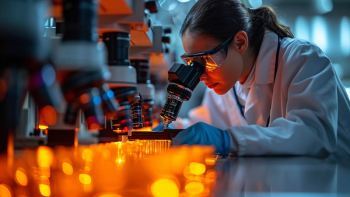
- Pharmaceutical Executive-03-01-2022
- Volume 42
- Issue 3
The Resilience of R&D: Pharma Posted Record Output in 2021
Despite disruption from the COVID-19 pandemic still in full swing, life sciences innovation activity remained undeterred, a recent report from the IQVIA Institute for Human Data Science finds—outlining the key factors driving record-breaking growth.
Widespread reports that the COVID-19 pandemic would slow down biopharmaceutical innovation have proven to be greatly exaggerated. Despite the severe challenges from the pandemic, the global biomedical innovation ecosystem has demonstrated remarkable resilience. By investing, adapting, drawing on existing innovations, and working continuously with fierce dedication, the life sciences industry, the academic research community, contract research organizations (CROs), and regulatory agencies have successfully worked together to accelerate R&D and deliver continued growth across almost all indicators.
Biopharmaceutical R&D continued in 2021 at a record-breaking pace, despite the backdrop of a global pandemic, with 5,500 new clinical trial starts and a 14% increase over 2020, according to a new report from the IQVIA Institute for Human Data Science titled Global Trends in R&D: Overview Through 2021. The astonishing achievements by healthcare stakeholders are a testament not only to the agility of the global life sciences industry, but they reflect the strength of the global biomedical innovation system to discover, develop, and receive regulatory approvals for new therapeutics.
Here are key highlights from the Global Trends in R&D report:
Clinical trial activity
Clinical trial activity was sustained through the pandemic as the industry has adapted to the disruption by applying innovative approaches—some existing but previously little used, others newly developed—to enable research to continue, including the mentioned new clinical trial starts and year-over-year increase that occurred last year. While the number of intended clinical trial starts dipped significantly in early 2020, the recovery began in June 2020 and has increased to record levels since then, even excluding the surge of clinical trials related to COVID vaccines and therapeutics, which has resulted in more than 1,200 industry-sponsored interventional trial starts since the beginning of 2020 (see Figure 1 below).
New drug approvals and growing pipeline
In 2021, new drug approvals and launches also accelerated, with more than 84 novel active substances (NASs) launched, double the number of five years ago. With a pipeline of more than 6,000 products in active development, up more than 67% compared with 2016, the level of pharma R&D is on pace to be sustained over years to come. The pipeline expansion has been most significant in oncology, gastrointestinal (GI) products, and neurology, while infectious diseases and vaccines, which had declining numbers of pipeline products until recently, saw significant growth largely driven by COVID-related therapeutics and vaccines. Almost the entire oncology pipeline includes some type of targeted therapy, and more than 40% of the pipeline is for rare cancers where next-generation biotherapeutics—including cell and gene therapies—are increasingly being deployed.
Clinical development productivity
The only decline in indicators is evidenced in clinical development productivity, which fell to its lowest point in 2021 driven by a decline in success rate offset by reduced trial complexity. The composite success rate across all therapy areas declined to 5% in 2021, which can be attributed to an appetite for increased risk in clinical development programs as the bar for efficacy and safety rises, as well as increased pauses in product development due to COVID. The composite Clinical Development Productivity Index—which combines success rates with trial complexity/duration—has dropped by 32% over the past decade (see Figure 2 below).
Across disease areas, 2021’s composite success rate fell below the 10-year trend, except for vaccines and cardiovascular, and probability of success varies considerably across diseases even as 2020 and 2021 represent extremely unusual years.
R&D funding
Venture capital deal activity and investment flows accelerated in the past two years, as interest in life sciences intensified, with more than 2,000 deals and more than $45 billion of deal value occurring in 2021. The 15 largest pharmaceutical companies invested a record $133 billion in 2021 in R&D expenditure, an increase of 44% since 2016 and maintaining a level of investment close to 20% of their recorded sales.
Over the past five years, deal activity has shifted geographically to include more companies headquartered in China and other countries in Asia and the Pacific, and while Europe-based organizations had more deals, they failed to keep pace and their share declined from 42% to 38%. North American life sciences companies represent the largest number and increase over the five-year period.
While transactions involving large pharmaceutical companies command much attention, their share of deals involving two life sciences companies has dropped from 51% of total deals in 2016 to 38% in 2021, as more emerging biopharmaceutical companies announce deals with each other (see Figure 3 below).
Emerging biopharma’s contribution to R&D
Emerging biopharma companies (EBPs)—those with an estimated expenditure on R&D of less than $200 million and less than $500 million in revenue annually—are responsible for a record 65% of the molecules in the R&D pipeline, up from less than 50% in 2016 and one-third in 2001 (see Figure 4 below). EBPs headquartered in China now account for 17% of the total EBP innovation pipeline, up from 6% just five years ago, and compares with 20% coming from Europe-based companies and 46% from US-based organizations, both of which have lost share over the same period.
Accelerator of innovation cycles
Efforts by all stakeholders to accelerate innovation cycles and bring scientific breakthroughs to patients faster are an enduring feature of the R&D landscape, and the median time from first patient filing to launch for US NASs fell to its lowest level in 2020 and 2021, including 21 drugs that were launched less than five years into their terms, compared with 16 in total over the period 2011–2019 (see Figure 5 below).
Reducing white space—the difference between the time a molecule takes to progress through clinical development and its clinical trial duration—is a major area of focus, and over the past decade varies from about seven years in the case of respiratory drugs to just one year for rare oncology drugs. In the case of COVID vaccines, this white space was dramatically reduced by more than eight years relative to pre-COVID vaccine benchmarks, due to a range of operational and organizational changes by sponsor companies and their partners, as well as varied financial and other external support from government and regulatory agencies.
The use of remote, virtual, or decentralized methods in clinical trials has accelerated in the past three years, enabling research continuity through the coronavirus pandemic, and advancing the industry position for scaling these key innovations in site, patient, and data management across the pipeline of developing medicines.
Implications for the life sciences industry
The incredible achievements in 2021 have boosted expectations for continued breakthroughs in R&D in 2022. There will continue to be many challenges to overcome for the life sciences industry to make the right investments, continue to accelerate clinical trial activity, and improve clinical development productivity. However, advances made during the pandemic in improving operational efficiencies and focus under pressure, in scaling implementation of innovation across all segments of the pipeline, and in forging partnership breakthroughs across the research ecosystem have the potential to fuel the delivery of more discoveries, with increasing effectiveness and accuracy, in the form of breakthrough novel medicines for patients who need them.
The full report, including methodology, is available at
Murray Aitken, Executive Director, IQVIA Institute for Human Data Science
Articles in this issue
almost 4 years ago
Pressed Into Action: Measuring Pharma’s Reputation Reversalalmost 4 years ago
Biopharma in 2021: Big Gains, Volatile Valuesalmost 4 years ago
New Age of Psychedelicsalmost 4 years ago
Roads Less Traveledalmost 4 years ago
Biopharma Stocks, M&A Sputter Amid More Headwindsalmost 4 years ago
Pandemic Accelerates CTV Ascent: How Pharma Can Benefitalmost 4 years ago
The Human Factor in Data Security Breachesalmost 4 years ago
Tapping the Surge in Useful Contingent Labor Marketalmost 4 years ago
Aligning the Many Interpretations of ‘Unmet Medical Need’Newsletter
Lead with insight with the Pharmaceutical Executive newsletter, featuring strategic analysis, leadership trends, and market intelligence for biopharma decision-makers.




